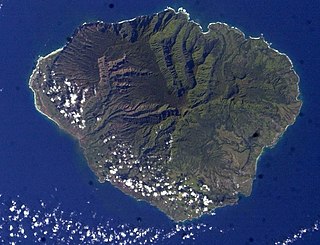
Kauaʻi, anglicized as Kauai, is one of the main Hawaiian Islands.

Hawaii is the largest island in the United States, located in the eponymous state of Hawaii. It is the southeasternmost of the Hawaiian Islands, a chain of volcanic islands in the North Pacific Ocean. With an area of 4,028 square miles (10,430 km2), it has 63% of the Hawaiian archipelago's combined landmass. However, it has only 13% of the archipelago's population. The island of Hawaiʻi is the third largest island in Polynesia, behind the north and south islands of New Zealand.

Laie is a census-designated place (CDP) located in the Koolauloa District on the island of Oahu in Honolulu County, Hawaii, United States. In Hawaiian, lāʻie means "ʻie leaf". The population was 5,963 at the 2020 census.
Plantations are farms specializing in cash crops, usually mainly planting a single crop, with perhaps ancillary areas for vegetables for eating and so on. Plantations, centered on a plantation house, grow crops including cotton, cannabis, coffee, tea, cocoa, sugar cane, opium, sisal, oil seeds, oil palms, fruits, rubber trees and forest trees. Protectionist policies and natural comparative advantage have sometimes contributed to determining where plantations are located.
Alexander & Baldwin, Inc. is an American company that was once part of the Big Five companies in territorial Hawaii. The company currently operates businesses in real estate, land operations, and materials and construction. It was also the last "Big Five" company to cultivate sugarcane. As of 2020, it remains one of the State of Hawaii's largest private landowners, owning over 28,000 acres (11,000 ha) and operating 36 income properties in the state.

Hans Peter (H.P.) Faye was a Norwegian-born businessman who developed sugarcane plantations on west Kauai.

Hāmākua is a district on the northeast coast of Hawaiʻi's Big Island, administered by the County of Hawaiʻi in the state of Hawaiʻi. It is also the name given for the coastline in the region, the "Hāmākua Coast".

Sugarcane or sugar cane is a species of tall, perennial grass that is used for sugar production. The plants are 2–6 m (6–20 ft) tall with stout, jointed, fibrous stalks that are rich in sucrose, which accumulates in the stalk internodes. Sugarcanes belong to the grass family, Poaceae, an economically important flowering plant family that includes maize, wheat, rice, and sorghum, and many forage crops. It is native to New Guinea.
A cane knife is a large hand-wielded cutting tool similar to a machete. Its use is prevalent in the harvesting of sugarcane in dominant cane-growing countries such as Peru, Brazil, Colombia, Australia, South Africa, Ecuador, Cuba, Jamaica, the Philippines and parts of the United States, especially Louisiana and Florida, as well as Hawaii. It is the primary tool used in countries that do not employ mechanical means for harvesting cane.
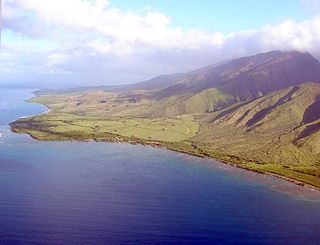
Olowalu is a community on the west side of the island of Maui in the state of Hawaii. It is located about 4 miles (6 km) south of Lahaina on the Honoapiʻilani Highway. It is a census-designated place (CDP), with a population at the 2020 census of 100.
Hawaii is one of the few U.S. states where coffee production is a significant economic industry – coffee is the second largest crop produced there. The 2019–2020 coffee harvest in Hawaii was valued at $102.9 million. As of the 2019-2020 harvest, coffee production in Hawaii accounted for 6,900 acres of land.

Ulupō Heiau on the eastern edge of Kawai Nui Marsh in Kailua, Hawaiʻi, is an ancient site associated in legend with the menehune, but later with high chiefs of Oʻahu, such as Kakuhihewa in the 15th century and Kualiʻi in the late 17th century. It may have reached the peak of its importance in 1750, before being abandoned after Oʻahu was conquered in the 1780s. The site became a territorial park in 1954, was partially restored in the early 1960s, marked with a bronze plaque by the State Commission on Historical Sites in 1962, and listed on the National Register of Historic Places in 1972.

The Haidu Mill or Haʻikū Sugar Mill was a processing factory for sugarcane from 1861 to 1879 on the island of Maui in Hawaii.
BASF Plant Science is a subsidiary of BASF in which all plant biotechnology activities are consolidated. The company was founded in 1998 and employs approximately 700 people at 6 different locations worldwide. The headquarters of BASF Plant Science is located in Research Triangle Park and has research sites in the US, Canada, and Europe. BASF Plant Science mainly develops genetically modified seeds at these locations.

There are two heritage railways in Kauai, the birthplace of Hawaiian railroading. It was added to the National Register of Historic Places on January 19, 1979.
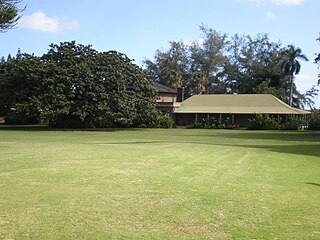
Grove Farm is a historic agricultural site on Kauai in the Hawaiian Islands.
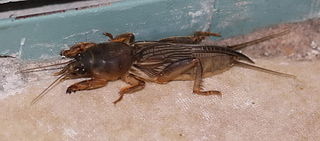
Gryllotalpa orientalis is a species of mole cricket in the family Gryllotalpidae, commonly known as the oriental mole cricket. It is found in much of Asia and Australasia. At one time, this species was misidentified as G. africana and thought to have a widespread distribution in both Africa and Asia, but in the 1980s, G. orientalis was recognised as a separate species. It is a polyphagous pest, damaging crops by gnawing their roots.
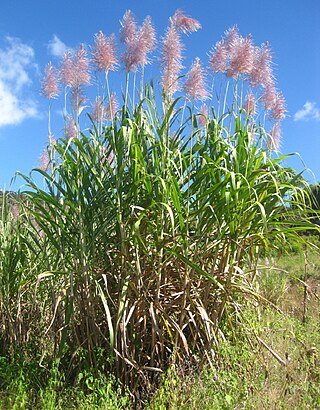
Saccharum officinarum is a large, strong-growing species of grass in the sugarcane genus. Its stout stalks are rich in sucrose, a disaccharide sugar which accumulates in the stalk internodes. It originated in New Guinea, and is now cultivated in tropical and subtropical countries worldwide for the production of sugar, ethanol and other products.
The sugar industry of the United States produces sugarcane and sugar beets, operates sugar refineries, and produces and markets refined sugars, sugar-sweetened goods, and other products. The United States is among the world's largest sugar producers. Unlike most other sugar producing countries, the United States has both large and well-developed sugarcane and sugar beet industries. Refined sugarcane, processed sugar beet, and high-fructose corn syrup are all commonly used in the U.S. as added sugars to sweeten food and beverages.
The economic history of Kaua’i, anglicized as Kauai, dates back to before the European colonization of Kauai and, in whole, Hawaii. Before Captain James Cook discovered the Hawaiian island chain in 1778, the native Polynesians of Kauai had a complex subsistence economy of fishing and trade among the other islands. In 1835, the first successful sugarcane plantation was established in Koloa, Kauai and was the beginning of a prosperous sugarcane industry. Sugarcane remained Kauai's most dominant industry until the mid-20th century. Today, Kauai is a tourism-centered economy with 1,279,968 people visiting the island in 2017. Visitor spending on the island the same year exceeded $1.83 billion—a 9.3% percent increase from the previous year. However, Kauai still boasts a strong agricultural economy with corn seed being the number one crop alongside coffee, guava, and taro.













